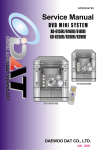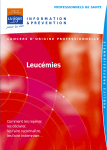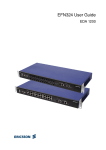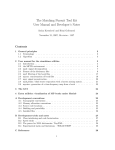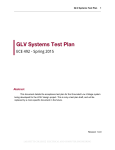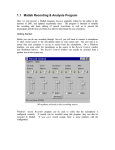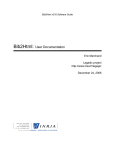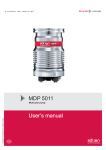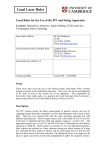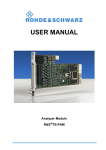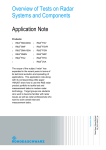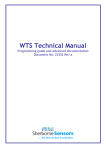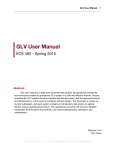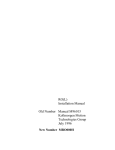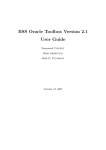Download "user manual"
Transcript
I IN ST IT UT DE E U Q I T A M R ET ES M È ST Y S E N RE CH ER C H E R IN F O I S S RE OI T ÉA AL A PUBLICATION INTERNE No 1706 BSS_EVAL TOOLBOX USER GUIDE REVISION 2.0 DEVELOPED WITH THE SUPPORT OF THE FRENCH GDR-ISIS/CNRS WORKGROUP “RESOURCES FOR AUDIO SOURCE SEPARATION” BY ISSN 1166-8687 C. FÉVOTTE , R. GRIBONVAL , E. VINCENT IRISA CAMPUS UNIVERSITAIRE DE BEAULIEU - 35042 RENNES CEDEX - FRANCE INSTITUT DE RECHERCHE EN INFORMATIQUE ET SYSTÈMES ALÉATOIRES Campus de Beaulieu – 35042 Rennes Cedex – France Tél. : (33) 02 99 84 71 00 – Fax : (33) 02 99 84 71 71 http://www.irisa.fr BSS EVAL Toolbox User Guide Revision 2.0 Developed with the support of the French GdR-ISIS/CNRS Workgroup “Resources for Audio Source Separation” by C. Févotte * , R. Gribonval ** , E. Vincent *** Systèmes cognitifs Projet Metiss Publication interne n˚1706 — April 2005 — 19 pages Abstract: This document is meant to help you use the BSS EVAL toolbox, which implements some criteria for performance measurement in (blind) source separation. The toolbox – which is r distributed under the terms of the GNU GENERAL PUBLIC LICENSE as a set of Matlab° **** routines – can be downloaded at the address http://www.irisa.fr/metiss/bss eval/. The purpose of this toolbox is to measure the performance of various source separation algorithms in an evaluation framework where the original sources, and perhaps even the noise that perturbed the mixture, are available for comparison. Key-words: source separation, performance measure, evaluation, source to distortion ratio, sources to interferences ratio, sources to noise ratio, sources to artifacts ratio, free software, user guide (Résumé : tsvp) * [email protected], Dept. of Engineering, University of Cambridge, Trumpington Street, Cambridge CB2 1PZ, UK. ** [email protected] *** [email protected] Centre for Digital Music, Queen Mary, University of London, Mile End Road London E1 4NS, UK. **** r is a registered trademark of The MathWorks, Inc. Matlab° Centre National de la Recherche Scientifique (UMR 6074) Université de Rennes 1 – Insa de Rennes Institut National de Recherche en Informatique et en Automatique – unité de recherche de Rennes Guide de l’utilisateur de la boı̂te à outils BSS EVAL Résumé : Ce document a pour objectif de vous aider à prendre en main et à utiliser la boı̂te à outils BSS EVAL, qui met en œuvre quelques critères de mesure de performance pour la séparation (aveugle) de sources. Cette boı̂te à outils – distribuée sous les termes de la licence r – peut être GNU GENERAL PUBLIC LICENSE en tant qu’ensemble de fonctions Matlab° téléchargée à l’adresse http://www.irisa.fr/metiss/bss eval/. L’objectif de cette boı̂te à outils est de mesurer la performance de divers algorithmes de séparation de sources dans un cadre d’évaluation où les sources d’origine, ainsi qu’éventuellement le bruit ajouté au mélange, sont disponibles pour servir de référence. Mots clés : séparation de sources, mesure de performance, évaluation, rapport source à distortion, rapport sources à interférences, rapport sources à bruit, rapport sources à artefacts, logiciel libre, guide de l’utilisateur BSS EVAL Toolbox 2.0 User Guide 3 Contents 1 Getting started 1.1 License - no warranty 1.2 Cite this as: . . . . . 1.3 Download and install 1.4 Getting help . . . . . 1.5 Reading guide . . . . . . . . . . . . . . . . . . . . . . . . . . . . . . . . . . . . . . . . . . . . . . . . . . . . . . . . . . . . . . . . . . . . . . . . . . . . . . . . . . . . . . . . . . . . . . . . . . . . . . . . . . . . . . . . . . . . . . . . . . . . . . . . . . . . . . . . . . . . . . . . . . . . . . . . . . . . . . . . . . . . . . . . . 4 4 4 4 5 5 2 User guide 2.1 Context . . . . . . . . . . . . . . . . . . 2.2 Principle . . . . . . . . . . . . . . . . . . 2.3 Global vs local criteria . . . . . . . . . . 2.4 Multiple target sources – advanced usage 2.5 Diagnostic – listening to the artifacts . . 2.6 Time-varying decompositions . . . . . . . . . . . . . . . . . . . . . . . . . . . . . . . . . . . . . . . . . . . . . . . . . . . . . . . . . . . . . . . . . . . . . . . . . . . . . . . . . . . . . . . . . . . . . . . . . . . . . . . . . . . . . . . . . . . . . . . . . . . . . . . . . . . . . . . . . . 6 6 6 7 8 8 8 3 Reference manual bss crit . . . . . . bss decomp gain . . bss decomp filt . . bss decomp tvgain . bss decomp tvfilt . bss proj . . . . . . bss tvproj . . . . . bss make frames . . bss make lags . . . bss energy ratios . . . . . . . . . . . . . . . . . . . . . . . . . . . . . . . . . . . . . . . . . . . . . . . . . . . . . . . . . . . . . . . . . . . . . . . . . . . . . . . . . . . . . . . . . . . . . . . . . . . . . . . . . . . . . . . . . . . . . . . . . . . . . . . . . . . . . . . . . . . . . . . . . . . . . . . . . . . . . . . . . . . . . . . . . . . . . . . . . . . . . . . . . . . . . . . . . . . . . . . . . . . . . . . . . . . . . . . . . . . . . 10 10 11 12 13 14 15 16 17 18 19 PI n˚1706 . . . . . . . . . . . . . . . . . . . . . . . . . . . . . . . . . . . . . . . . . . . . . . . . . . . . . . . . . . . . . . . . . . . . . . . . . . . . . . . . . . . . . . . . . . . . . . . . . . . . . . . . . . . . . . . . . . . . . . . . . . . . . . . . . . . . . . . . . . . . 4 Févotte, Gribonval & Vincent Chapter 1 Getting started This document is meant to help you use the BSS EVAL toolbox, which implements the criteria for performance measurement in (blind) source separation described in the papers [1, 2]. 1.1 License - no warranty The toolbox is distributed under the terms of the GNU GENERAL PUBLIC LICENSE as a r 1 routines so you should first get familiar with Matlab° r to use it. set of Matlab° 1.2 Cite this as: Within the limits of the GNU GENERAL PUBLIC LICENSE, you can use the toolbox as you please. If you use the toolbox in a work of your own that you wish to publish, please cite this user manual [3] including the URL of the toolbox • C. Févotte, R. Gribonval and E. Vincent, BSS EVAL Toolbox User Guide, IRISA Technical Report 1706, Rennes, France, April 2005. http://www.irisa.fr/metiss/bss eval/. 1.3 Download and install The latest version of the toolbox can be downloaded at http://www.irisa.fr/metiss/bss eval/. Once you have downloaded and uncompressed the toolbox you should get the following toolbox files • LICENSE.txt • Contents.m • bss crit.m • bss decomp gain.m • bss decomp filt.m 1 r is a registered trademark of The MathWorks, Inc. Matlab° Irisa BSS EVAL Toolbox 2.0 User Guide 5 • bss decomp tvgain.m • bss decomp tvfilt.m • bss proj.m • bss tvproj.m • bss make frames.m • bss make lags.m • bss energy ratios.m as well as the present documentation in PostScript and PDF: user guide.ps, user guide.pdf. 1.4 Getting help r , from the directory where the toolbox files are located, you can get basic Within Matlab° online help on the various functions of the toolbox by typing help Contents r path you can simply type If you have added the toolbox directory to the Matlab° help BSS_EVAL 1.5 Reading guide In chapter 2 you will learn how to use the various functions of the toolbox to compute performance measures for source separation. Chapter 3 gives a detailed documentation for each function of the toolbox. PI n˚1706 6 Févotte, Gribonval & Vincent Chapter 2 User guide 2.1 Context The purpose of this toolbox is to measure the performance of various source separation algorithms in an evaluation framework where the original sources, and perhaps even the noise that perturbed the mixture, are available for comparison. 2.2 Principle The principle of the performance measures described in [1] is to decompose a given estimate sb(t) of a source si (t) as a sum sb(t) = starget (t) + einterf (t) + enoise (t) + eartif (t) (2.1) where starget (t) is an allowed deformation of the target source si (t), einterf (t) is an allowed deformation of the sources which accounts for the interferences of the unwanted sources, enoise (t) is an allowed deformation of the perturbating noise (but not the sources), and eartif (t) is an “artifact” term that may correspond to artifacts of the separation algorithm such as musical noise, etc. or simply to deformations induced by the separation algorithm that are not allowed. There are several ways of computing such a decomposition depending on which transformations are allowed, and the toolbox includes the function bss decomp gain (resp. bss decomp filt, bss decomp tvgain, bss decomp tvfilt) to perform the decomposition when the allowed deformation is a constant gain (resp. a constant filter, a time-varying gain, a time-varying filter). As an example, you would type [s target, e interf, e noise, e artif] = bss decomp gain(se, i, S, N) (2.2) r ) with S(i,:) to get the decomposition of the estimated source se (a row vector in Matlab° the target source, S(j,:), j 6= i (the rows of the matrix S) the other sources, and N(k,:) the perturbating noise signals. In the case where the noise signals are not known or there is no noise, you would simply type [s target, e interf, e artif] = bss decomp gain(se, i, S) (2.3) Given such a decomposition, one can compute performance criteria either globally or, as we will see later, locally. Four global performance measures are defined : the Source to Distortion Irisa BSS EVAL Toolbox 2.0 User Guide 7 Ratio SDR := 10 log10 keinterf kstarget k2 , + enoise + eartif k2 (2.4) the Source to Interferences Ratio SIR := 10 log10 kstarget k2 , keinterf k2 (2.5) kstarget + einterf k2 , kenoise k2 (2.6) kstarget + einterf + enoise k2 . keartif k2 (2.7) the Sources to Noise Ratio SNR := 10 log10 and the Sources to Artifacts Ratio SAR := 10 log10 To compute these criteria, simply type [SDR, SIR, SNR, SAR] = bss crit(s target, e interf, e noise, e artif) (2.8) In case e noise has not been computed, you can also type [SDR, SIR, SAR] = bss crit(s target, e interf, e artif) 2.3 (2.9) Global vs local criteria Sometimes, it is not very satisfying to summarize the performance by a single figure for the whole signal: it may happen that on some pieces of the estimated signal the interferences are very low because the target source is loud, but on other pieces the target source vanishes. To obtain local performance measures we provide the syntax [SDR, SIR, SNR, SAR] = bss crit(s target, e interf, e noise, e artif, window, NOVERLAP) (2.10) where the meaning of window and NOVERLAP is the same as in the specgram function of r Signal Processing Toolbox. It is not important whether the window is smooth Matlab° (its only effect is to compute local performance measures, but no FFT is performed, no sidelobes are to be feared, etc.) so you can safely use rectangular windows such as ones(1,512). With this syntax, instead of being a number, SDR (resp. SIR, SNR and SDR) is a column vector which entries SDR(n) correspond to the local performance on the n-th frame, that is to say SDR(n) := 10 log10 kw(t − tn ) · starget (t)k2 . kw(t − tn ) · (einterf (t) + enoise (t) + eartif (t)) k2 (2.11) Use plot(SDR) to display the variations of these performance measures along the frames, or compute and display its cumulative histogram to get statistics on its values. PI n˚1706 8 2.4 Févotte, Gribonval & Vincent Multiple target sources – advanced usage Estimating a single specific source si (t) is only one of the many goals in “source separation”: it happens that one may be more interested in recovering estimates of combinations of several sources. For example, in karaoke, sb(t) will be good if the voice source has been correctly rejected, but it does not really matter if the result is a reasonable deformation of the other sources. To measure the performance in such contexts, one can use the decomposition functions (bss decomp gain, etc.) as [s target, e interf, e noise, e artif] = bss decomp gain(se, index, S, N) (2.12) with index a column vector of indices indicating which sources (rows of S) are target sources. Thus, in the karaoke example, index would contain all the sources indexes except for the voice. 2.5 Diagnostic – listening to the artifacts By examining (or listening to) the signals [s target,e interf,e noise,e artif], one can determine whether the chosen decomposition (that is to say the set of allowed distortions) is meaningful for the target at hand, in particular whether the notion of “artifacts” meets its intuitive meaning. 2.6 Time-varying decompositions When using the decompositions designed to deal with time-varying gains or time-varying filters, you must specify a “shape” v(t) of the variations and a step (in number of samples) which together determine which variations are considered admissible. Since the smoothness of v(t) determines that of the allowed variations, you will probably want to avoid the rectangular window (unless you want to allow piecewise constant gains / piecewise constant filters). A good choice would probably be to use a triangular window (for piecewise linear variations) or higher order splines. Irisa BSS EVAL Toolbox 2.0 User Guide 9 Bibliography [1] E. Vincent, R. Gribonval, and C. Févotte, “Performance measurement in blind audio source separation,” IEEE Trans. Speech and Audio Proc., 2005, to appear. [2] R. Gribonval, L. Benaroya, E. Vincent, and C. Févotte, “Proposals for performance measurement in source separation,” in Proc. 4th Int. Symp. on Independent Component Anal. and Blind Signal Separation (ICA2003), Nara, Japan, Apr. 2003, pp. 763–768. [3] C. Févotte, R. Gribonval, and E. Vincent, “BSS EVAL toolbox user guide,” IRISA, Rennes, France, Tech. Rep. 1706, 2005. [Online]. Available: http://www.irisa.fr/metiss/bss eval/ PI n˚1706 10 Févotte, Gribonval & Vincent Chapter 3 Reference manual bss crit Purpose: Computes evaluation criteria given a decomposition of an estimated source into target sources, interfering sources, perturbating noise and artifacts contributions. Synopsis (global mode): [SDR,SIR,SAR] = bss crit(s target,e interf,e artif) [SDR,SIR,SNR,SAR] = bss crit(s target,e interf,e noise,e artif) Synopsis (local mode): [SDR,SIR,SAR] = bss crit(s target,e interf,e artif,WINDOW,NOVERLAP) [SDR,SIR,SNR,SAR] = bss crit(s target,e interf,e noise,e artif,WINDOW,NOVERLAP) Input: Name s target e interf e noise e artif WINDOW NOVERLAP Description contribution of the target source(s) contribution of interfering sources (optional) contribution of perturbating noise contribution of artifacts row vector containing the window used in local mode number of samples of overlap between adjacent windows Output (global mode): SDR, SIR, SNR and SAR are scalars Output (local mode): SDR, SIR, SNR and SAR are column vectors which entries correspond to the local performance on each frame, see Eq. (2.11). Irisa BSS EVAL Toolbox 2.0 User Guide 11 bss decomp gain Synopsis: [s target,e interf,e artif] = bss decomp gain(se,index,S) [s target,e interf,e noise,e artif] = bss decomp gain(se,index,S,N) Description: Decomposes an estimated source into the contributions of the target sources, of the interfering sources, of perturbating noise and of the rest named artifacts. The only allowed deformation is a pure gain, so when the input sources and noises are mutually orthogonal, the contributions are computed based on the model X X X sb(t) = ai · si (t) + aj · sj (t) + bk · nk (t) + eartif (t). (3.1) i∈I j ∈I / k See [1] or the file bss gain.m to learn how the contributions are computed for non mutually orthogonal input. Input: Name se index S N Description row vector representing the estimated source sb(t) column vector of indices of the target sources in the rows of S, representing the set I matrix which rows correspond to the original sources (target si (t), i ∈ I + interfering sj (t), j ∈ /I ) (optional) matrix which rows correspond to the perturbating noise signals nk (t) Output: s target, e interf, e noise, e artif : row vectors of the same dimension as se. PI n˚1706 12 Févotte, Gribonval & Vincent bss decomp filt Synopsis: [s target,e interf,e artif] = bss decomp filt(se,index,S,L) [s target,e interf,e noise,e artif] = bss decomp filt(se,index,S,N,L) Description: Decomposes an estimated source into the contributions of the target sources, of the interfering sources, of perturbating noise and of the rest named artifacts. The only allowed deformation is a pure filter, of controled tap length, so when the input sources and noises are mutually orthogonal the contributions are computed based on the model sb(t) = L−1 XX i∈I l=0 ai (l) · si (t − l) + L−1 XX j ∈I / l=0 aj (l) · sj (t − l) + L−1 XX k bk (l) · nk (t − l) + eartif (t). (3.2) l=0 See [1] or the file bss filt.m to learn how the contributions are computed for non mutually orthogonal input. Input: Name se index S N L Description row vector representing the estimated source sb(t) column vector of indices of the target sources in the rows of S, representing the set I matrix which rows correspond to the original sources (target si (t), i ∈ I + interfering sj (t), j ∈ / I) (optional) matrix which rows correspond to the perturbating noise signals number of taps allowed in the distorting filters Output: s target, e interf, e noise, e artif : row vectors of the same dimension as se. Irisa BSS EVAL Toolbox 2.0 User Guide 13 bss decomp tvgain Synopsis: [s target,e interf,e artif] = bss decomp tvgain(se,index,S, tvshape, tvstep) [s target,e interf,e noise,e artif] = bss decomp tvgain(se,index,S,N, tvshape, tvstep) Description: Decomposes an estimated source into the contributions of the target sources, of the interfering sources, of perturbating noise and of the rest named artifacts. The only allowed deformation is a (slowly) time varying gain, so when the input sources and noises are mutually orthogonal the contributions are computed based on the model X X X sb(t) = ai (t)si (t) + aj (t)sj (t) + bk (t)nk (t) + eartif (t) (3.3) i∈I j ∈I / k where the gains ai (t) (resp. bk (t)) are slowly time-varying in the sense that they have the parametric form X ai (t) = αi (r) · v(t − r · T ) (3.4) r with v(t) a smooth “window” and T À 1 a rate of variation. See [1] or the file bss tvgain.m to learn how the contributions are computed for non mutually orthogonal input. Input: Name se index S N tvshape tvstep Description row vector representing the estimated source sb(t) column vector of indices of the target sources in the rows of S, representing the set I matrix which rows correspond to the original sources (target si (t), i ∈ I + interfering sj (t), j ∈ / I) (optional) matrix which rows correspond to the perturbating noise signals row vector containing the shape v(t) of the variations of the gain number of samples T of distance between adjacent variations of the gain Output: s target, e interf, e noise, e artif : row vectors of the same dimension as se. PI n˚1706 14 Févotte, Gribonval & Vincent bss decomp tvfilt Synopsis: [s target,e interf,e artif] = bss decomp tvfilt(se,index,S,tvshape,tvstep,L) [s target,e interf,e noise,e artif] = bss decomp tvfilt(se,index,S,N,tvshape,tvstep,L) Description: Decomposes an estimated source into the contributions of the target sources, of the interfering sources, of perturbating noise and of the rest named artifacts. The only allowed deformation is a (slowly) time varying filter, so when the input sources and noises are mutually orthogonal the contributions are computed based on the model sb(t) = L−1 XX i∈I l=0 ai (l, t)·si (t−l)+ L−1 XX aj (l, t)·sj (t−l)+ j ∈I / l=0 L−1 XX k bk (l, t)·nk (t−l)+eartif (t) (3.5) l=0 where the filter coefficients ai (l, t) (resp. bk (l, t)) vary slowly with time in the sense that they have the parametric form X ai (l, t) = αi (l, r) · v(t − r · T ). (3.6) r with v(t) a smooth “window” and T À 1 a rate of variation. See [1] or the file bss tvfilt.m to learn how the contributions are computed for non mutually orthogonal input. Input: Name se index S N tvshape tvstep L Description row vector representing the estimated source sb(t) column vector of indices of the target sources in the rows of S, representing the set I matrix which rows correspond to the original sources (target si (t), i ∈ I + interfering sj (t), j ∈ / I) (optional) matrix which rows correspond to the perturbating noise signals row vector containing the shape v(t) of the variations of the gain number of samples T of distance between adjacent variations of the gain number of taps allowed in the distorting filters Output: s target, e interf, e noise, e artif : row vectors of the same dimension as se. Irisa BSS EVAL Toolbox 2.0 User Guide 15 bss proj Synopsis: PY x = bss proj(x,Y) [PY x coeff] = bss proj(x,Y) Description: Computes the orthogonal projection of a signal x(t) onto the subspace spanned by other signals yi (t), that is to say X ci yi (t) (3.7) PY x(t) = i with x − PY x orthogonal to each vector yi . Input: Name x Y Description row vector representing the signal x(t) matrix or row vector which rows correspond to the signals yi (t) Output: Name PY x coeff Description row vector representing the projected signal PY x(t) column vector corresponding to the coefficients ci Remark: The projection will not properly work if the rows of Y are linearly dependent (e.g., if two sources are identical). PI n˚1706 16 Févotte, Gribonval & Vincent bss tvproj Synopsis: PY x = bss tvproj(x,Y,tvshape,tvstep) [PY x coeff] = bss tvproj(x,Y,tvshape,tvstep) Description: Computes the orthogonal projection of a signal x(t) onto the subspace spanned by the windowed versions of other signals yi (t), that is to say X ci,r · v(t − rT ) · yi (t) (3.8) PY x(t) = i,r with x(t) − PY x(t) orthogonal to each windowed vector v(t − rT ) · yi (t). Input: Name x Y tvshape tvstep Description row vector representing the signal x(t) matrix or row vector which rows correspond to the signals yi (t) row vector containing the shape v(t) of the window number of samples T of distance between adjacent variations of the gain Output: Name PY x coeff Description row vector representing the projected signal PY x(t) matrix corresponding to the coefficients ci,r (rows correspond to rows of Y, columns to frames) Irisa BSS EVAL Toolbox 2.0 User Guide bss make frames Synopsis: [F S frames index] = bss make frames(S,WINDOW,NOVERLAP) Description: Decompose some signal(s) into frames Input: Name S WINDOW NOVERLAP Description matrix of size n × T which rows correspond to the signals yi (t) row vector of size 1 × W containing the window number of samples of overlap between adjacent windows Output: Name FS Description nf rames × W × n tensor containing the frames (of length W ) of each row of S frames indexindex of the beginning of each frame in the rows of S Remark: If n = 1, F S is a matrix of size nf rames × W PI n˚1706 17 18 Févotte, Gribonval & Vincent bss make lags Synopsis: S lags = bss make lags(S,L) Description: Create a matrix containing lagged (delayed) versions of some signals. Input: Name S L Description matrix of size n × T which rows contain input signals sn (t) number of lagged versions of the signal(s) Output: Name S lagged Description matrix of size (nL) × T which rows represent the lagged signals Irisa BSS EVAL Toolbox 2.0 User Guide 19 bss energy ratios Purpose: Computes energy ratios corresponding to SDR/SIR/SNR/SAR given a decomposition of an estimated source into target sources, interfering sources, perturbating noise and artifacts contributions. Synopsis: [SDR,SIR,SAR] = bss energy ratios(F s target,F e interf,F e artif) [SDR,SIR,SNR,SAR] = bss energy ratios(F s target,F e interf,F e noise,F e artif) Input: Name Description F s target nf rames x T matrix containing the frames of the contribution of the target source(s) F e interf nf rames x T matrix containing the frames of the contribution of interfering sources F e noise (optional) nf rames x T matrix containing the frames of the contribution of perturbating noise F e artif nf rames x T matrix containing the frames of the contribution of artifacts Output: SDR, SIR, SNR and SAR are column vectors of size nf rames which entries correspond to the local performance on each frame, see Eq. (2.11). PI n˚1706






















